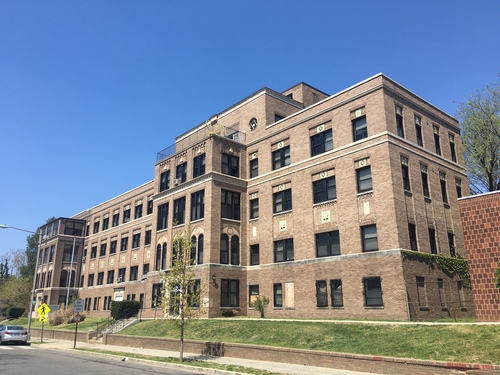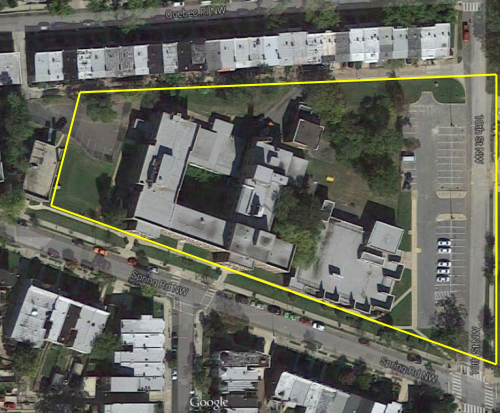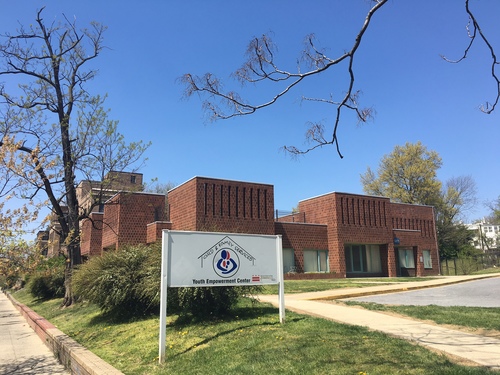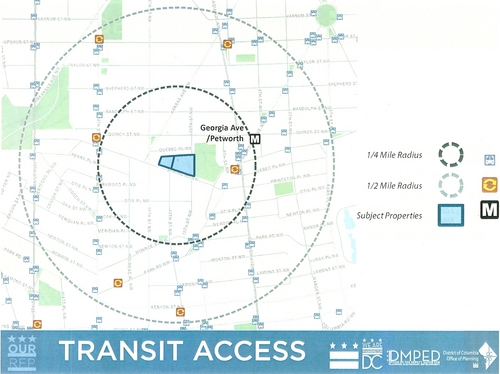The first two efforts to turn Petworth’s Hebrew Home into housing failed. Will the third time be different?
Just a few blocks from the Petworth Metro, a District-owned apartment that most call the Hebrew Home has been vacant since 2009, and DC is asking for resident input on its latest effort to redevelop the land (the first two fell through). The end result could be 200 new units of mixed-income housing, along with retail and park space.
Located at 1125 Spring Road, the Hebrew Home’s name is a reference to the building’s original use serving the elderly Jewish population with housing and health care. From 1925 to 1969, the property grew to include an array of social services available to young and old within a community that both understood and supported the specific religious, linguistic, and cultural needs of its clients.
When the Hebrew Home determined it could no longer adequately serve the needs of the local Jewish population by remaining on Spring Road, it sold the property to the District government and moved into a new facility in Montgomery County.
This isn’t the first effort to redevelop the Hebrew Home
From 1968 until its closure in 2009, the District used the Hebrew Home site as a mental health facility for the homeless. Since it closed that facility, the District has attempted to breathe new life into the building without success.
In the fall of 2010, the DC Department of Human Services proposed using the site to shelter families instead of sending them to DC General. That plan would have cost an estimated $800,000 to renovate the building for 74 families. However, the site was removed from consideration due to then-Councilmember Muriel Bowser’s concern that the immediate area had an “inordinate amount of group homes” and two homeless shelters within a two-block radius of the site.
More recently, efforts in 2014 to redevelop the historic structure and the Robeson School (which sits immediately adjacent, to the east) resulted in a plan to create approximately 200-units of housing with 90% designated as affordable, including a senior preference for 25% of the units.
Development stalled again, however, when the District learned that it wouldn’t be able to transfer ownership to the DC Housing Authority without a formal Request for Proposals process. Moreover, Bowser expressed reservations about the plan being weighted so heavily toward affordable housing. Due to these factors, the District restarted the process to develop the site in April with what it’s calling OurRFP, a process in which the city solicits input from community members on how to use a site before developers start submitting proposals.
The Hebrew Home could become much-needed housing for all incomes
The first of two OurRFP workshops to decide how to redevelop the Hebrew Home was earlier this month. There, officials from DC’s office of the Deputy Mayor for Planning and Economic Development (DMPED) shared some key data:
- The lot is 144,400 square feet in size.
- The site includes three buildings. The development will not include the small building at the western edge of the site.
- The former Hebrew Home structure is historic, but the Robeson School is not and can be razed.
- The property has good access to transportation. It’s near the Georgia Avenue Metro station, numerous bus lines, and Capital Bikeshare stations.
- The site has a walk score of 93 and a bike score in the 80s.
Workshop attendees split into 13 working groups to discuss what they would like to see happen with the Hebrew Home.
The site has tremendous potential to provide a significant amount of housing in an area with ready access to public transportation and where housing prices and displacement are of great concern. Within my working group, there was general agreement that the RFP should start from the position of including a strong affordability component, with the financing then driving the configuration of affordable and market rate housing to a balanced level. There was an understanding that the economics of development will have an impact on what can be financed and that, at the end of the day, the development must become a reality for any housing to exist.
With regards to the living units, there’s a need for both family-sized units and apartments for seniors. I would like to see every unit (if possible) be ADA compliant; as units become vacant in the future it would be ideal if any resident in need of housing would be able to move into the building and not be prevented due to the unit’s configuration.

A map showing existing affordable housing surrounding the Hebrew Home site by location and number of affordable units. Image from DMPED.
As for the type of building that goes up, it is clear that people want the new construction to fit into the neighborhood context. Whether the building was traditional, modern, contemporary, or something else, the materials, massing, and architectural detailing’s ability to make it fit the character of what’s around it certainly exists.
We also discussed the massing of the new construction on the Robeson site. Some suggested that a by-right approach would be more in keeping with the neighborhood and better fit in. I countered that I would prefer a Planned Unit Development— where a developer provides the community with benefits in exchange for a zoning exception— for three reasons:
- A PUD would allow for a slightly larger building. The existing Hebrew Home building is one story taller than allowed by by right, and I think that an additional story on the new construction that matched the height of the historic building would not be out of place, especially as it would be located between the Hebrew Home site and the Raymond School & Recreation Center.
- A PUD would also result in more oversight and community opportunities to participate.
- As zoned, the building is residential. But the existing Hebrew Home building has a space on the first floor with a separate entrance that could support a small store or possibly another use such as an early childhood development center.
I think the community would benefit from vetting these options to see if they’re a good fit rather than not discussing them at all.
One of the last things the group discussed was the public space and sustainability. As part of this discussion, we talked about trees, benches, green roofs, and other possible uses for the existing green spaces. As this is an opportunity to enhance our natural environment, I also mentioned that we should advocate for all trees and landscaping to be native plantings. The green space between the small building at 1131 Spring Road and the Hebrew Home is also large enough for a small park or other type of public space.
There will be another OurRFP workshop in May, and DMPED anticipates releasing the RFP solicitation in June 2016.
A version of this post originally ran on Park View, DC.




